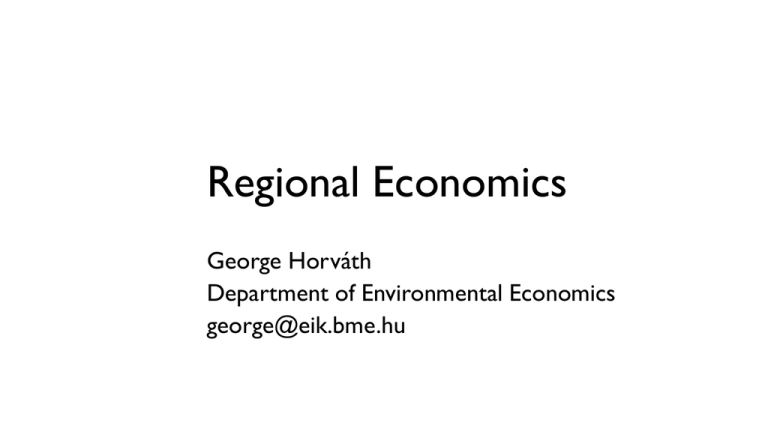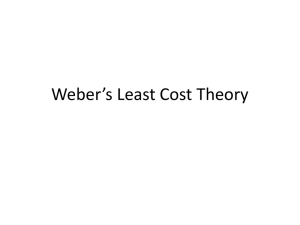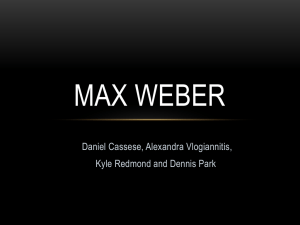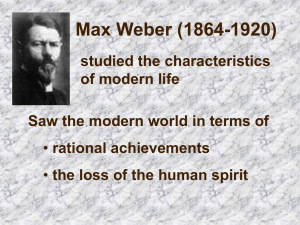Regional Economics
advertisement

Regional Economics George Horváth Department of Environmental Economics george@eik.bme.hu The origins of Regional Economics • Spatial development and settlement theory did not form part of early Political Economy • Early economic theory focused on a „one-point economy” • Most significant problems were value, distribution issues and taxation • First efforts in regional economics were taken by economically trained industrialists, agriculturalists and transport professionals • They encountered the rules and decision-making problems of regional economics during their professional work • This original interdisciplinarity is still present 1 Formulating regional economic theory Formulation of Economic Theory follows a historical logic: 1. First: agricultural issues, second: locating industry, third: locating all other sectors. Transportation as the means of bridging distances has also been treated in regional economics from the early days. 2. Regional economics first dealt with locating individual businesses, i.e.: microeconomic approach. Only later did it start focusing on locating several businesses, i.e.: macroeconomic approach. 3. Regional economics treated competitive scenarios first, later it dealt with monopolistic situations too, eventually dealing with the problem of externalities. 2 Properties of spatiality and its relationship to spatial development Aspects of the spatial dimension Spatial and geographic adjacency Spatial and geographic dissimilarity Spatial and geographic distance and mobility Spatial and geographic extent and fragmentation } } } Urban and Spatial planning Spatial development, Regional policy Spatial and Territorial administration 3 Comparing the „one-point economy and the spatially extensive economy categories one-point spatially extensive Market Uniform, homogenous (same prices) Near-average Structured and dissimilar in space Spatially dissimilar (local) Economic reactions Perfect (on both Input and Product markets) Identical Market information Perfect Imperfect (geographic monopoly) Different (local culture and particularities) Spatially asymmetric Market behaviour Rational Consumer preferences Homogenous Substitutability Unlimited Economic equilibrium Equilibrium is the standard state Input (costs) Competition Spatially restricted rational Spatially inhomogenous Limited by spatial allocation of resources Disequilibrium is the standard state 4 Regional economics among sciences Economic Sciences Regional Economics Geographic, technical and legal sciences 5 The elements of Regional Economics • Location theory • Theory of Economic Space (spatial structures, city and settlement networks, markets in space, agglomerations) • Regions, regional economic growth and development in space } Microeconomics } Macroeconomics 6 Location theories and locating factors • • • • • Theory of agricultural location (von Thünen) Theory of industrial location (Weber) Location of commerce Location of services Theory of choosing a habitation location (Alonso) 7 Different interpretations of Location National level: • Tax regime, customs, tariffs and duties • Economic and legal regulations • Economic and population growth • Political and economic stability • EU membership Regional level • Quantity and qualification of workforce • Proximity and access to motorways • Vicinity of national frontier • Economic structure Local level • Price and appropriateness of the real estate (land) • Accessibility of utilities • Local taxes and subventions • Local industry • Cooperative opportunities • Schools, universities and training facilities 8 Weber’s theory of Industrial Location • Logically speaking, the first regional economic theories were on Industrial Locations (historically speaking, though, the first ones were on agricultural locations.) • The founder of the Economic Theories of Industrial Location was Alfred Weber • His magnum opus was published in 1909: „On the Locations of the Industries” (Über den Standort der Industrien) 9 Locative factors in Weber’s theory • Such factors which transform the conditions of productions favourably to producers (agglomerative factors) • Benefits arising from the proximity of either resources (raw materials) or markets (transportation costs) 10 Effects and benefits in Weber’s Theory • Agglomerative benefits and transport costs act in opposing directions • Their equilibrium determines the optimal location • The agglomerative effect acts towards the highest concentration of activity… • …but the requirement that locations should be in the proximity of resources and labour, as well as consumers and markets, acts in the opposing direction. 11 Agglomerative benefits 1. Benefits arising from an increase in size of a particular plant (economies of scale) 2. Benefits arising from the increase in the number of businesses in the same economic sector (specialised suppliers, qualified work force, availability of management and technical know-how), known as „localisation benefits” 3. Urbanisational benefits arising from the infrastructure and size of a big city 12 Agglomerative drawbacks 1. Increased price of work force and required land 2. Drawbacks of congestion (noise, pollution, criminality, social problems) 3. As concentration increases, some of the markets will become more distant, thus increasing transportation costs 13 Main groups of Industrial Location Theories Cost Minimising theories • Price is a given factor, producers have no influence • Location of competitive companies does not affect sales • An increase in profit can only be achieved by cutting production and transport costs Weber’s Theory is a cost minimising theory 14 Main groups of Industrial Location Theories Profit Maximising theories • Price is not a given factor; it depends on – The location of customers – The location of producers – The location of competitive firms – The strategy of competitive firms • Demand is not focussed in a single point, but rather, it is spatially distributed 15 Examining factors: transportation • Some raw materials are to be transported, others are not (air, water, etc.) • Non-transport cost differences exist in raw materials, intermediary and end-products, e.g.: – Depth of mines – Quality of raw materials • All non-transport cost differences are converted into transport costs • This is a „reverse iceberg” model 16 Suppositions in Weber’s model • Demand for a product exists at a single point in space • Two kinds of raw materials exist, in two points, removed from both the market and each other • The market is perfectly competitive • The sale price of the product is given and inelastic • All possible locations implement the same technology, therefore costs incurred must be the same everywhere 17 Question: where to settle industry? • Weber’s Theory deals with the problem of finding an optimal location for industry. • What are the scenarios? – Locating the industry near the market – Locating it near the raw material – Find an intermediary „compromise” location 18 Scenario I: locating near the market • An industry will settle near the consumer market, if – The final product is heavier than the aggregate weight of the raw materials, energy sources and intermediary products, or otherwise, if – The final product is not heavier than the aggregate weight, but transportation costs of the final product are so high that they would over-compensate the difference in weight. • Typical examples: – Beverages (high water demand) – Paints, thinners, etc. (again, high water demand) – Perishable goods (foods, etc.) 19 Scenario 2: locating near raw materials • • An industry will settle near the raw materials or sources of energy, if the industry is heavily dependent on these. Examples: – Construction materials – Oil refining – Smelting (blast furnaces) – Alimentation (flour milling, sugar and canning industry) 20 Scenario 3: other locations? • • • • What if the industry does not produce for a single market only, and/or requires more than just a few raw materials and energy sources? If there is no single item (either on the input or output side) that would dominate the production, where should we locate the industry? The solution: finding a compromise location! How do we define such a location? 21 Defining a compromise location • • Weber uses a formula to define a locative criterion He defines material indices: – For each tonne of product, an amount of each component (raw material, energy, etc.) is needed – These quantities must be put in during the process – One tonne of final product is the output – a1, a2, a3, a4, etc. • • • Aggregate amount of „quantities” to be moved: ∑ai+1 This amount is called the „weight of the location” (T) Using these indices, defining a location becomes more straight forward 22 Three possible locations 1. An industry will be located near an input material if there exists a material index ai, which exceeds half the sum of all input weights (i.e.: half of the weight of location, T), such that ai> T∕2 2. The industry will be located near the product markets if the weight of the product exceeds half the sum of all input weights (ie.: half of the weight of location, T), such that 1> T∕ , or T<2. 2 3. A compromise location will be chosen if none of the above conditions hold true, i.e.: ai< T∕2 , and 1< T∕2 or T>2. 23 Working with a compromise location • • • If there is only a single raw material and a single product market, there cannot exist a third, „intermediary” or „compromise” location, since one of the material weights will probably exceed half the location weight. Should they be exactly equal, choosing an „intermediary” location is still unlikely to be beneficial, as the costs of loading and unloading between the two end points (raw material or the market) will increase costs. Even randomly choosing one will be cheaper. Compromise locations can only be defined when there are at least two raw materials and one market, or one raw material and two markets. 24 Finding a compromise location Let’s suppose we have… • Two raw materials (A and B) • One market (C) …located geographically as shown below: A B C 25 Finding a compromise location • • We need to find a point P inside the bounding triangle with the smallest possible associated „import” and „export” costs. We’re looking for a certain „centre of mass” of the triangle, but not the geometric centre of mass. A P B C 26 Finding a compromise location • We’re after a point where the product of the transport tariffs and the import and export costs w1t1s1+ w2t2s2 + w3t3s3→min wi = point-specific import & export weights (material&product index) ti = transport tariffs of materials and products si = distances from the end points, defining the distance from P A P B C 27 A possible compromise location A P B C 28 Compromise locations in real life Let’s suppose that we have two raw materials and one market, just like before, A here, here, and here. B C 29 A possible compromise location We do the maths again, and we identify our compromise location. A P B C Let’s see this on our map now. 30 And here it is. A P B C Can we spot any problems? 31 Our „optimal” compromise location is in the middle of nowhere! • • • No roads. No railroads. There aren’t even any towns close by! A P B C So can this be „optimal”? 32 Wouldn’t it be more practical to have our location elsewhere? Here, because there’s a road? Here, because it’s close to the river? A P B C Here, because it’s near a town? Here, because of the railroad? Weber’s model can give some strange results. 33 Let’s take a scenario just like before: A C B Where will we find a compromise location? 34 Weber’s model offers this solution: A C P B Surely, this can’t be a feasible location. 35 Associated mathematical problems • There is no simple „one-step solution” for determining a compromise location • An iterative process needs to be carried out, which takes several additional steps • There is no single guideline iteration for solving the problem • Possible solutions have been published (such as Harold Kuhn and Robert Kuenne’s solution) • Even if a compromise location is found, it may not be practical in real life 36 On the issue of workers • We need to take into consideration the issue of workers as well • We need workers for the factory (obviously) • Workers tend to „live somewhere” • At the time of the formulation of the theorem, commuting was not an everyday phenomenon, so a given workforce was only available locally • From Weber’s point of view, the advantages and disadvantages arising from the level of training of the workforce would only be reflected in their wages 37 Weber’s formulation of this question • Let’s suppose that there exists another city, where wages are lower compared to the optimal (compromise) location (which was determined through transport costs), then • Considering possible savings in costs and expenses, would it be worthwhile for the industry to locate nearer to where the workforce lives (and bear the additional transport costs on both input and output side)? 38 Weber’s solution • As previously, Weber projects labour costs on a quantity of final product (one tonne) • He first calculates the amount of labour required for the production of a tonne of final product. • The then divides this quantity by the aggregate weight of all materials going in and out of the factory, i.e.: the weight of the location • We get an index number, which he calls labour coefficient (Arbeitskoeffizient, A) • We can now directly work with labour costs 39 What this means • If A1 is the labour coefficient at the „optimal” (with the supposedly higher labour costs), and • A2 is the labour coefficient at the city with the supposedly lower labour costs, then • The difference A1-A2 will indicate the savings in labour expenditure. 40 Working this out with formulae • If the new location would be at a distance of S kilometres from the optimal location, and the cost of transportation would be t per tonne, a switch of location would only be worthwhile, if T∙S∙t < A1-A2 • In such a situation, we would replace some of the labour costs with additional transport costs. • Hopefully, this would result in a saving. • If not, DON’T do it! • This substitution effect has become a 41 fundamental part of location theories. About market effects • When treating labour, it becomes obvious that Weber does not consider the effect companies have on wages: • If a new factory locates in a town, this will have an effect on wages (increase) so the calculated savings on wages will not be realised. • Even though Weber’s Model is considered to be a cost-minimising approach, by disregarding market responses we cannot even calculate cost savings. 42 Agglomeration effects ag· glom· er· ate, vb: to form or be formed into a mass or cluster • as firms in related industries cluster together, costs of production may decline significantly – firms have competing multiple suppliers – greater specialization and division of labour • Even when competitors agglomerate, benefits may be reaped, as the cluster attracts more suppliers and buyers • Cities grow because of such effects! • It relates to two main ideas: – Economies of Scale – Network Effects 43 Advantages of agglomeration • Influx of new information and practices • This can bring down fixed costs of production • As fixed costs fall, a stage of economies of scale is reached 44 Disdvantages of agglomeration • City growth may only be persistent if advantages constantly outweigh disadvantages • Adverse effects may appear – Congestion – Pollution – Criminality – Other negative externalities of clustering • Pricing power of the firms will decrease, as shortage of labour becomes apparent 45 Back to Weber’s Model According to Weber, companies have two alternative paths to take: 1. Establish two separate factories, each near its own suppliers and markets, at optimal distances between the two 2. Establish a single factory with the combined production capacity of the hypothetical two factories, which would be located at a not optimal site, but the additional transport costs would be covered by the savings through economies of scale Which alternative should one choose? 46 Sounds familiar? • • • It should; the logic of solving this problem is exactly the same as the problem of labour. A move away from the optimal location results in an increase in costs. However, savings will be realised in some fixed costs that don’t increase with size: – Administration – Buildings and real estate – Production and development costs – Marketing • If the benefits of economies of scale outweigh the losses through locating away from the optimum, it’s worthwile to build a larger factory 47 Working this out with formulae • Let’s consider fixed costs C and the mass of products from each plant W1 and W2 • As previously, T is the weight of the location, S is the distance from our • The criterion for building a larger factory is therefore 2C C T St W1 W2 W1 W2 48 To wrap up Weber’s Model • Weber considers each factor one after the other. • If we began by leaving the optimal location for benefits of cheaper labour, we then start out from this new point when we consider the effects of agglomeration and economies of scale • Savings have to cover an increase in the cost of labour as well! 49 To wrap up Weber’s Model • Even though it has a number of known flaws, Weber’s model remains a cornerstone in regional economics • It has been a logical guideline for locating industry for several decades • Even today it has some applications 49







